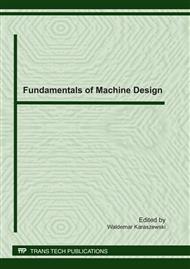p.257
p.265
p.273
p.282
p.288
p.296
p.305
p.312
p.323
The Influence of Geometrical Parameters on the Friction Process in the Needle Bearing
Abstract:
The article analyses the process of friction in the needle bearing as the function of the alterations of geometrical parameters, namely the diameter of the shaft – D, the needle – d and the bearing clearance. The change in the relation between the diameters D and d results in the change of the contact area of the friction pair; in the case of two shafts with parallel axes (the needle of the bearing and the shaft pin) the contact area, if compared with the analogical process in the ball bearing, alters significantly and leads to resistance in motion. There are two types of friction in the needle bearing: the rolling friction and the sliding friction; the analysis of the movement of the bearing elements enabled the estimation of the extent to which the sliding friction matters in the overall balance of motion resistance. The article also defines the type of wear as the function of initial clearance.
Info:
Periodical:
Pages:
288-295
Citation:
Online since:
September 2011
Authors:
Keywords:
Price:
Сopyright:
© 2012 Trans Tech Publications Ltd. All Rights Reserved
Share:
Citation:


